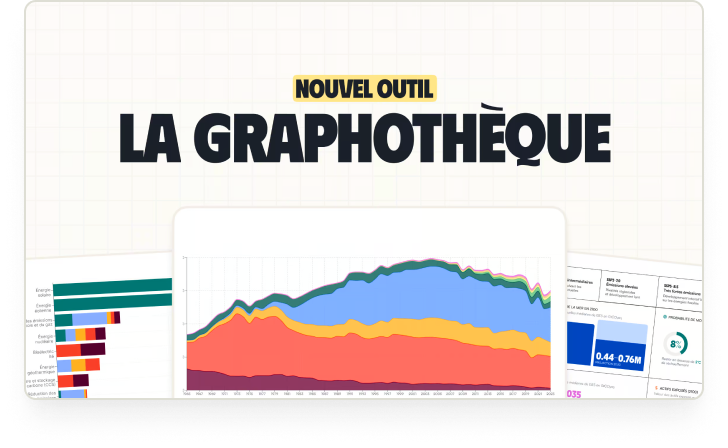Carbon footprint or climate shadow?
You’re probably familiar with the concept of carbon footprint, or material footprint. But do you know what climate shadow is? In 2021, journalist Emma Pattee wrote an article about the climate shadow. “One of the reasons I created Climate Shadow is my frustration with carbon footprinting and the way it devalues actions that can’t be measured, such as voting or activism,” she tells The Guardian.
While the climate shadow has definite advantages, and opens up discussions on climate change with regard to different responsibilities, ethics and exemplarity, it nevertheless has significant limitations, and some untruths that its author seems to ignore.
Definition of climate shadow
According to Emma Pattee, theclimate shadow is a concept “to help each of us visualize how the sum of our life choices influences the climate emergency“.
Imagine your climatic shadow as a dark shape extending behind you. Wherever you go, it goes too, accounting not just for your air-conditioning use and your car’s gas consumption, but also for how you vote, how many children you choose to have, where you work, how you invest your money, how much you talk about climate change, and whether your words amplify urgency, apathy or denial.
Consumption, choice and dedicated energy
Emma Pattee visualizes the climate shadow as being made up of three parts: consumption, choice and influence.
- Consumption would include lifestyle expectations, like running the air conditioning all summer or wishing for two-day delivery when you shop online, as well as your participation in consumer culture (posting new purchases on Instagram, spending money that goes to a long-term sustainable business or supply chain) and, of course, your carbon footprint.
- Choices would include how you donate and invest your money, how many children and pets you have, the type of company you work for and the work you do for it.
- According to Emma Pattee,influence is the most nebulous, but perhaps the most important: how much of my energy is devoted to the climate crisis? How many hours do I devote to climate action? Is it at least as much as I spend watching Netflix, planning my next vacation?
Emma Pattee’s climate shadow dilemma
To illustrate what climate shadow is, Emma Pattee begins her article like this:
Let’s take the example of two people: one flies to work every week; the other lives in a studio and walks to work every day. At first glance, it’s obvious that one has a larger carbon footprint than the other. It’s well known that air travel is a highly polluting means of transport, and when you compare a weekly flight with the energy consumption of a small house and the emissions of a daily walk, the result is obvious.
But there’s a catch: the weekly traveler is a climatologist who travels the world to inform about the dangers of climate change. The second person works in a marketing agency and produces such ads for an oil company. So, who contributes most to the climate emergency?
Before going into the advantages and limitations of the concept, we can already point out that reality is a little less binary than this simple example. Here, for example, is a statement by the scientist Katharine Hayhoe, who agrees with the journalist:
I decided to transform most of my conferences into virtual conferences and, when I was traveling, to group my conferences together. One of my last group trips was to Alaska, where I visited three different cities and organized 28 events with an average of 75 people per event. So I spoke to around 2,000 people and calculated that if eight people reduced their individual carbon footprint by 10% by listening to me speak – and a 10% reduction is very easy to achieve – that was the carbon equivalent of my flight.
NASA climatologist Peter Kalmus, on the other hand, takes a different view of the climate shadow. “Its main flaw: the introductory example is wrong. You don’t have to fly every week – or at all – to teach the world about climate and environmental degradation. I’m a climate scientist who hasn’t flown in nine years, and I’ve reached more people because of it.” As is often the case, it’s a little more complicated than expected…
What are the advantages of climatic shade?
The main advantage of the climate shadow is that it goes beyond simple carbon accounting, whose rules are arbitrary and have their own limitations. This allows us to go beyond the carbon footprint and look at other angles, such as ethics, exemplarity and the energy devoted to the cause.
Exemplarity has a special place in the climate shadow. We know today, and there’s no doubt about it, that exemplarity is an important vector in climate communication, as numerous scientific studies attest. Indeed, a scientist who takes to the air and brags about it on social networks would be making a communication error that would have a disastrous effect on his credibility. Yet that would only have the carbon footprint of a tweet.
It’s the same for everyone, and all the more important if you have an audience. Flying around the world isn’t a good idea for the climate, and even less so if you have an audience and are promoting it on social networks.
On the other hand, imagine a Cristiano Ronaldo with 600 million followers on Instagram or Kylian Mbappé with 106 million who suddenly decide to say that they are not exemplary but will now do everything they can to limit their impact because the fight against climate change far outweighs their own interests?

Voting, coffee machines and (truly) responsible business
Political voting and engagement are two elements not considered by the carbon footprint, but which the climate shadow wishes to take into account. Even if voting has its limits, especially in a voting system where millions of people vote by default, we can’t conclude that voting has no impact. Voting for the far right or any conservative party is particularly harmful to the fight against climate change, and would be shooting yourself in the foot if you really want to combat global warming.
Discussions at the coffee machine can also have a tangible effect, and will never be counted or calculated accurately. Imagine convincing the director of a major corporation to train all employees on climate change and the collapse of biodiversity? Convincing the head of the CSE that trips to the other side of the world should no longer be offered or subsidized, while at the same time proposing an alternative?

Finally, the choice of company, illustrated with a case study. An engineer working for an oil company praises his work in improving drilling efficiency. This will improve his company’s carbon footprint. But what if this process justifies new drilling operations, such as TotalEnergies and EACOP, whose direct consequence is non-compliance with the Paris Agreement and deaths in the tens of thousands?
Chaque semaine, nous filtrons le superflu pour vous offrir l’essentiel, fiable et sourcé
The (very) major limitations of the climate shadow article
Emma Pattee’s article has a number of limitations, whether in terms of understanding carbon footprints, carbon accounting or the examples given. It would take hours to explain everything that’s wrong, but fortunately most of it has already been covered in articles on Bon Pote.
Firstly, and this is a piece of fake news repeated even by environmental activists, the carbon footprint concept was not invented by British Petroleum. Information is also presented as if individual and collective actions were dissociable, but this is not the case. The two are combined, and this presentation is a shortcut (just like saying that individual actions only account for 25%: it’s not true).
Emma Pattee seems to want to pit the carbon footprint against the climate shadow. “To find out the true extent of your impact on the planet, I invite you to disregard your carbon footprint. Look behind you, at your shadow”. Why oppose the two approaches? It’s counterproductive. These are two useful approaches, each with its own advantages and shortcomings, and it’s important to be aware of their limitations.
“Measures everything except what’s really important“.
It’s also wrong to say that the carbon footprint“measures everything except what’s really important“. Take five minutes and do the test: isn’t travel, food, housing and leisure really important? Let’s add that having one child less is cited as one of the five most important personal actions. We’ ve seen that it’s a little more complicated than that. Ditto for the 2-tonne figure that would be the carbon footprint target. Again, it’s a bit more complicated than that, especially for an American!
Finally, in France, if a climatologist flies to work, the emissions are included in the laboratory’s emissions. If this laboratory is public, the emissions are shared by all French people (which doesn’t mean they shouldn’t be lowered!).
The limits and risks of the climate shadow
Although the concept of the “climate shadow” is debated by scientists, it is only the subject ofno peer-reviewed work. It would probably be interesting to have people working on the calculations, but even if that were the case, it’s not certain that we’ll have anything reliable by 2030, or even 2050… the consequentiality of emissions is already a major gap in current carbon accounting, so it’s hard to imagine how we could accurately calculate the climate shadow.
Like Emma Pattee, the carbon footprint concept is often presented as a tool that redirects responsibility for climate change onto individuals, whereas the climate shadow avoids this pitfall. Once again, simulate your carbon footprint, bearing in mind that the French need to go from an average of 10 tonnes CO2 eq to less than 2 tonnes. This is impossible without structural change and a radical shift in the consumerist approach of today’s economy.
Finally, it goes without saying that the climate shadow should not be used to “offset” the various actions you may undertake. Just because you’re a climatologist working all year round to combat climate change doesn’t mean you can fly every two months in exchange.
Imagine if everyone had this logic, and started finding excuses to maintain their unsustainable lifestyles. Can the founder of Bon Pote afford 2-3 return flights to Dubai, since readers have told him they’ve vacationed in Europe by train rather than going to New Zealand?
While you’re on the subject…
The climate shadow can be an opportunity to launch exciting discussions on responsibility for climate change and solutions for achieving carbon neutrality. It is not to be contrasted with the carbon footprint, which should be seen as a complementary concept. What is certain is that the quantitative approach has its limits, and the climate shadow provides a partial answer.
Imagine a trip by a renowned paleoclimatologist like Valérie Masson-Delmotte to New York for a climate conference. How can we be sure that this intervention will lead to avoided emissions? Could this talk have been given by video, or by another American climatologist? Is the audience already convinced, or is it a neophyte, and several people will take “a climate slap” like some members of the Convention Citoyenne pour le Climat after Valérie Masson Delmotte’s masterful speech?
Finally, talking about carbon footprint, material footprint, or climate shadow is beneficial. If the debates revolve a little more around this subject and a little less around Cyril Hanouna’s latest stupidity on TPMP, we’ll have taken a big step forward.













